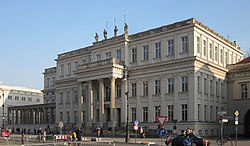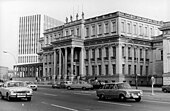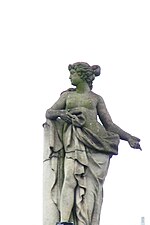Kronprinzenpalais
| Kronprinzenpalais | |
|---|---|
 Kronprinzenpalais | |
| Former names | Königliches Palais |
| General information | |
| Type | Palace |
| Architectural style | Neoclassical |
| Town or city | Berlin |
| Country | Germany |
| Coordinates | 52°31′01″N 13°23′46″E / 52.517°N 13.396°E |
| Completed | 1663 (original) 1857 (renovation) |
| Renovated | 1970 (reconstruction) |
| Design and construction | |
| Architect(s) | Heinrich Strack (renovation) Richard Paulick (reconstruction) |
The Kronprinzenpalais (English: Crown Prince's Palace) is a former
Earliest uses
Johann Arnold Nering created the building in 1663–69 as the private residence of Cabinet Secretary Johann Martitz, converting an existing middle-class house.[2][3] From 1706 to 1732, it was the official residence of the governor of Berlin.[4]
Remodelling and use as a royal palace


In 1732,
The building was then renovated and refurnished in Neoclassical style (with furniture from Prussia rather than France) and became the residence of Crown Prince Frederick William (the future
In 1856–57,
Their eldest son, who would be the last German Emperor as
Modern annexe of the National Gallery
After the dissolution of the monarchy, the palace became a possession of the State of Prussia, which gave it to the National Gallery in 1919 to house its drawing collection.[15][16] The director, Ludwig Justi, used this annexe to the existing building (now known as the Alte Nationalgalerie) to house a new department devoted to living artists, the Galerie der Lebenden, something which he had proposed the previous year and which contemporary artists themselves had been demanding.[6][16][17][18][19] This opened on 4 August 1919[20] with approximately 150 paintings and sculptures including naturalistic and French Impressionist works, a sculpture by Rodin (in a room retaining the old palace décor, which also featured paintings by Cézanne, Van Gogh, and Manet), works representing both the establishment Verein Berliner Künstler and the Berlin Secession, and on the top floor in a temporary display, works by members of Die Brücke and other Expressionists.[16][19][21] This was the first state promotion in Germany of Expressionist works, which were unpopular with large numbers of the public.[22] The gallery was a pioneer of the museum of contemporary art; in the judgement of the assistant director of the National Gallery at the time, the collection was superior to that of all other German galleries then collecting modern art.[23] It served as a model for later institutions,[21] notably the Museum of Modern Art in New York, which opened two years after its first director, Alfred H. Barr Jr., visited the Kronprinzenpalais in 1927.[16][24][25] On the other hand, the art critic Karl Scheffler, who favoured Impressionism and disliked Expressionism, attacked Justi for opening the contemporary art gallery, publishing a book in 1921 with the title Berliner Museumskrieg (Berlin Museum War).[26]
After the Nazis
In the 1937 Nazi operation against Entartete Kunst (degenerate art), the National Gallery lost a total of 435 works.
Later in 1937, the building became the seat of the Prussian Academy of Arts, whose building in Pariser Platz had been requisitioned by Albert Speer's office.[45] The Director of the Schauspielhaus theatre in the Gendarmenmarkt, Gustaf Gründgens, also temporarily had his office in the building.[46]
In March 1945, the Kronprinzenpalais was gutted in an Allied bomb attack. Until 1958, a ballet school used a remaining rear section, but the site was entirely cleared in 1961.[47]
Reconstruction and postwar uses

In 1968–69, to complete the restoration of the south side of Unter den Linden and make a suitable visual transition to the newly completed
The garden, which extends from Oberwallstraße to Niederlagstraße and has underground parking garages under part of it, was newly laid out in 1969–70 by W. Hinkefuß and descends in terraces to a central lawn, and then rises again in further terraces to a restaurant called the Schinkelklause, which incorporates pieces of terracotta and an entrance from Schinkel's Bauakademie, which was partially destroyed in World War II and demolished around 1960. The sculptures in the garden are by Senta Baldamus, Gerhard Thierse and Gerhard Lichtenfelds.[4][47]
From 1998 to 2003, the Kronprinzenpalais was used as temporary exhibit space by the
References
- ^ Kronprinzenpalais (in German) Landesdenkmalamt Berlin
- ^ (in German)
- ISBN 9783865680501, p. 148(in German)
- ^ a b c d e f g h i j Kronprinzenpalais Archived 2015-07-05 at the Wayback Machine, Denkmale in Berlin, Senatsverwaltung für Stadtentwicklung und Umwelt (in German)
- ^ ISBN 9783406598135, pp. 109–11(in German)
- ^ ISBN 9781900639286, p. 32.
- ISBN 9783406343957, pp. 395–409, p. 395(in German)
- ISBN 9783770155774, pp. 123–24(in German)
- ISBN 9780521761987, p. 54.
- ^ Giloi, p. 196.
- ISBN 9783406343957, p. 419(in German)
- ^ Kaiserin Friedrich als Künstlerin: Künstlerische Bestrebungen am preußischen Hof in Berlin Archived 2013-10-02 at the Wayback Machine, Kaiserin Friedrich.de (in German)
- ^ "Nach der Ausrufung der Republik in Berlin", photograph by Otto Haeckel, 9 November 1918, at German Historical Museum [dead link]
- ^ "Revolution in Berlin 9 November 1918" Archived 6 January 2013 at archive.today, the same picture at Wissenschaft am Abgrund: Weltkrieg und Revolution, slideshow with instructional captions.
- ^ According to Giloi, p. 345, the Prinzessinnenpalais as well.
- ^ ISBN 9781409405863, p. 112.
- .
- ISBN 9781857099607, p. 55.
- ^ ISBN 9780226890593, p. 85.
- ISBN 9783926796011, p. 3(in German)
- ^ a b Uwe Prell, "Berlin—Bühne des Wandels—Ein Reisebericht", PhD dissertation, Free University of Berlin, Chapter 3 (pdf) p. 284 (in German)
- ISBN 9780838641682, p. 96.
- ISBN 9780810936539, p. 116.
- ^ Forster-Hahn, p. 16.
- : "Our institution seeks to fulfil the function of a Kronprinzenpalais!"
- OCLC 251357313(in German)
- ISBN 9780807822401, p. 48: Goebbels wrote in his diary on 15 December 1935: "With the Führer at midday.... The crap must be cleansed from the Kronprinzenpalais."
- ^ Janda, p. 69.
- ^ a b Anja Heuss, Das Schicksal der jüdischen Kunstsammlung von Ismar Littmann. Ein neuer Fall von Kunstraub wirft grundsätzliche Fragen auf, Neue Zürcher Zeitung, 17 August 1998 (in German) (online at Kulturartikel 2 Archived 2008-03-27 at the Wayback Machine, B'nai B'rith Augustin Keller Loge, Zurich).
- .
- ^ Petropoulos, Art as Politics, pp. 60–61.
- ^ "Magere Schultern", Der Spiegel, 9 September 1968 (in German)
- ISBN 9783878470892, p. 15(in German)
- ^ Ecksteins, n.p.
- (in German)
- ^ According to Der Spiegel, it lost a total of around 500 works, 170 of them paintings.
- ^ ISBN 9783050051895, p. 74(in German)
- ^ Petropoulos, Art as Politics, p. 20.
- ^ Petropoulos, Faustian Bargain, p. 16.
- ^ a b Rosebrock, pp. 73–74.
- ^ Petropoulos, Art as Politics, p. 56.
- ^ Petropoulos, Art as Politics, p. 57.
- ^ Petropoulos, Art as Politics, pp. 79–80.
- ^ Petropoulos, Art as Politics, p. 81.
- ^ Petropoulos, Art as Politics, p. 73, p. 335, note 100.
- ^ "Tanz auf dem Vulkan", Der Spiegel, 28 September 1981 (in German)
- ^ a b c d e f g Nikolaus Bernau, "Das Kronprinzenpalais Unter den Linden. Ein Denkmal der DDR-Moderne", Museumsjournal Berlin 1 (1999) 4–9 (online at Schlosdebatte.de) (in German)
- ISBN 9783428002016, p. 125(in German)
- ISBN 9783791326467, p. 56, photo p. 57.
- Max Planck Institute, 2005, retrieved 27 August 2012.
- ^ Severin Weiland, "Ausstellung 'Erzwungene Wege': Auf schmalem Grat", Der Spiegel, 10 August 2006 (in German)
- ^ Pressestimmen zur Ausstellung 'Erzwungene Wege—Flucht und Vertreibung im Europa des 20. Jahrhunderts' Archived 2009-03-20 at the Wayback Machine Zeitgeschichte-online, 7 September 2006, retrieved 22 August 2012 (pdf) (in German)
- ^ Katharina Klotz, "Kronprinzenpalais: Heimatweh—Eine Trilogie", Museumsjournal 2 (2012) p. 90 (in German)
Further reading
- Paul Seidel. "Zur Geschichte des Kronprinzen-Palais in Berlin, insbesondere der ehemaligen Wohnung der Königin Luise". Hohenzollern-Jahrbuch 11 (1907) 206–57 (in German)
- Jörg Haspel. "Rekonstruktion als städtebauliche Denkmalpflege? Das Kronprinzenpalais in Berlin". In Rekonstruktion in der Denkmalpflege. Überlegungen, Definitionen, Erfahrungsberichte. Ed. Juliane Kirschbaum and Annegret Klein. Schriftenreihe des Deutschen Nationalkomitees für Denkmalschutz 57. Bonn: Deutsches Nationalkomitee für Denkmalschutz, 1998. OCLC 470203880. pp. 75–81 (in German)
- Crown Prince’s Palace: Contract Signing in a Magnificent Building. In: Sites of Unity (Haus der Geschichte), 2022.
External links
- 360° panoramas of Kronprinzenpalais, exteriors and historically reconstructed interiors for performance of Alma
- "Kaiser und Könige", illustrated history of the building to 1919 at the Alma site (in German)








